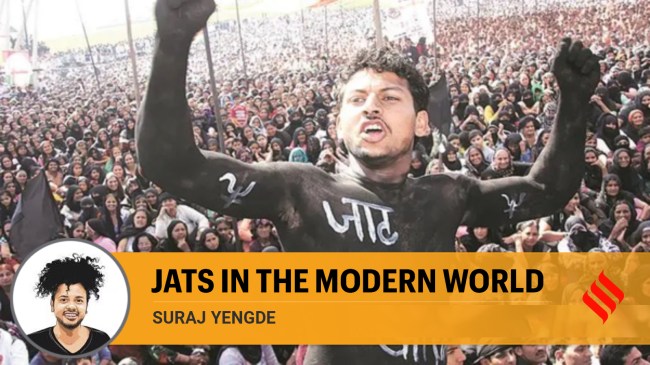Opinion Jats in the modern world
A band of proud people, Jats, with their traditional outlook on worldly affairs, are now grappling with the politics of the nation that has transitioned into a democracy.
 Wherever they went, Jats refused to give up the pride of their past. (File)
Wherever they went, Jats refused to give up the pride of their past. (File) The tale of Jats, also ‘Jatts’ or ‘Jaats’, in India is about 500 years old. Leading nomadic lives that revolved around their livestock, the Jats belonged to diverse geographies, from the mountains of Eastern Europe and Central Asia to the sea-adjacent plain fields.
Many who settled in Sindh started moving northwards between the 17th and 18th centuries. Mujmal-ut-Tawarikh, an Arabic account of the Sindh region, attributes the origin of Jats to the son of Noah, Ham, which in turn attributes it to the now-known scientific terms ‘Aryans’ and ‘Scythians’. The same origin is conveyed to the Rajput clans inhabiting the same region as Jats in India.
Jats arrived during mediaeval times in Punjab and also intermixed with the native population. This was the time and place where many battles were fought between Muslims, Sikhs and Hindus.
In each chronicle, and on each side, Jats find a mention. Though not traditional caste warriors, in the sense of caste (Kshatriyas), their settlement into a sedentary lifestyle made them prone to attacks and invasions. And to protect their settlements, they converted their tools into weapons.
Referring to Jats as a singular group is a grave fallacy since they are a group of several sub-caste tribes divided by gotras. Both rich land-owning farmers and petty peasants derive their ancestry from Jats who migrated.
Many Jats carried their traditional practices into modern life, including their heavily endogamous methods to select partners or settling disputes through the infamous khap panchayats, a contested form of delivering justice.
Jats strategically placed their faith in their practice of agrarian work. With relatives spread among the Hindus, Muslims and Sikhs, they embraced their newfound faith positively and remained in that structure.
During the spread of Buddhism, Jats adopted the religion en masse. Ram Sarup Joon, a well-known Jat historian and author, writes that Buddhism was favoured as a religion over Brahminism. Some Jat clans even travelled to China and other regions to spread Dhamma. In colonial times, they took on the liberal cause of Arya Samaj and became its member.
A band of proud people, Jats, with their traditional outlook on worldly affairs, are now grappling with the politics of the nation that has transitioned into a democracy.
After receiving state approval for their trade, a massive lobby worked to gain a foothold to advocate for a kisan rashtra (farmer nation). With farmers being advertised across the media, movies, and textbooks as hardworking and benevolent guardians who fed us, a subaltern agrarian appeal was made to give way to their aspirations.
Despite their history, the Jats are mocked and customarily derided among North Indian groups. Popular myths and stories easily carry the tag of Jats too.
Wherever they went, Jats refused to give up the pride of their past. (The first Sikh guru) Guru Nanak’s father-in-law and many relatives were administrators for Jat landlords. The Jats were on a par with landed kshatriyas.
However, Jats seem to have missed the understanding of pride with confidence. Today, in politics, popular culture and sports, one notices how they keep petitioning the world on their qualities and superiority, even when no one asks them to. They have a strong desire to assert without a bona fide avenue.
Though they are mostly found in north India today, there is hardly any intimate exchange between the diverse Jat groups. Religious divisions have created a radical rift between them, turning the former clansmen into archrivals. However, they present a united front on issues that gain national political momentum, such as farmers’ issues, land legislation and bargaining with the government for their rights. And despite being a predominantly North Indian group, they have managed to provide national leaders.
After Suraj Mal, the 18th century Jat ruler of Bharatpur, the community received much greater fame under Chaudhary Charan Singh, who was elected as the fifth prime minister of India. Sir Chhotu Ram and Raja Mahendra Pratap Singh, a Nobel Peace Prize nominee in 1932, are other notable Jat icons who preceded Singh. However, the Jat story is confined only to those in the Hindu fold — the Tikaits, the Hoodas and the Chaudharys. But Sikh and Muslim Jats have driven their conservative agenda within the regional template of politics in India and Pakistan.
With modernisation of land-related occupations and change in the feudal order, Jats are anxious about their future. Democratic practices have challenged many who are now trying to reinvent their identities and futures.
After Singh, the Jats received a new face in the form of vice president Jagdeep Dhankhar. Superseding the national realm, Olympians from the Jat community have brought international fame to their community and their politics. Wrestlers Sakshi Malik, Bajrang Punia and Vinesh Phogat, also from the Jat community, are now holding the government accountable — just like their farmer cousins.
Yengde, author of Caste Matters, curates Dalitality and is currently at Oxford University






